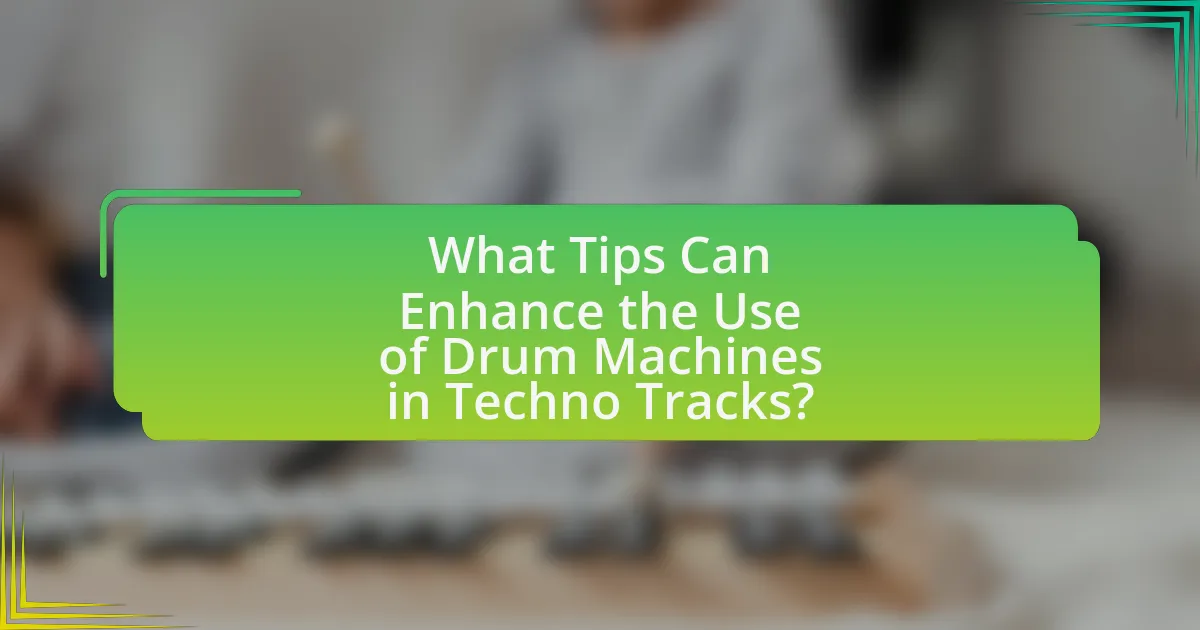Drum machines are essential electronic devices in techno music, providing programmable and consistent percussion sounds that shape the genre’s rhythmic foundation. This article explores the functionality of drum machines in music production, detailing their key components, sound generation methods, and the unique sounds they offer for techno tracks. It also addresses common challenges faced by producers, such as programming complexity and sound quality issues, while providing practical tips for effective use, including sound selection, layering techniques, and integration with other instruments. By understanding these aspects, producers can enhance their techno tracks and create engaging, dynamic compositions.

What are Drum Machines and Their Role in Techno Music?
Drum machines are electronic devices designed to create percussion sounds and rhythms, playing a crucial role in techno music by providing consistent and programmable beats. These machines allow producers to craft intricate patterns and manipulate sounds, which is essential for the driving, repetitive nature of techno. Historically, drum machines like the Roland TR-808 and TR-909 have been pivotal in shaping the genre, as they offer distinctive sounds that define techno tracks. Their ability to produce a wide range of drum sounds and effects enables artists to experiment and innovate, making them indispensable tools in the production of techno music.
How do Drum Machines function in music production?
Drum machines function in music production by generating rhythmic patterns and sounds that mimic traditional percussion instruments. They allow producers to create beats by programming sequences of sounds, which can be triggered in real-time or arranged in a timeline. Drum machines often include a variety of samples and synthesis options, enabling users to customize sounds to fit specific genres, such as techno. The use of drum machines in techno tracks is prevalent due to their ability to produce consistent, high-energy rhythms that are essential for the genre’s driving beats.
What are the key components of a Drum Machine?
The key components of a drum machine include sound generation, sequencing, user interface, and connectivity options. Sound generation is responsible for producing drum sounds, which can be synthesized or sampled. Sequencing allows users to arrange and program rhythms, often through a grid or step sequencer. The user interface provides controls for adjusting parameters like tempo, volume, and effects, facilitating ease of use. Connectivity options, such as MIDI and audio outputs, enable integration with other instruments and devices, enhancing versatility in music production. These components collectively define the functionality and usability of a drum machine in creating techno tracks.
How do different Drum Machines vary in functionality?
Different drum machines vary in functionality primarily through their sound generation methods, sequencing capabilities, and user interfaces. For instance, some drum machines utilize sample-based sounds, allowing users to load and manipulate audio samples, while others rely on synthesized sounds, providing a broader range of tonal possibilities. Additionally, sequencing capabilities differ; some machines offer advanced features like step sequencing, real-time recording, and pattern chaining, which enhance creative flexibility. User interfaces also vary, with some drum machines featuring touchscreens for intuitive control, while others utilize traditional knobs and buttons for tactile interaction. These differences impact how producers create and arrange beats, influencing the overall sound and workflow in techno music production.
Why are Drum Machines popular in Techno tracks?
Drum machines are popular in Techno tracks because they provide precise, consistent rhythms that are essential for the genre’s driving beats. The ability to program intricate patterns and manipulate sounds allows producers to create complex, layered compositions that define Techno music. Historically, iconic drum machines like the Roland TR-808 and TR-909 have shaped the sound of Techno since the 1980s, offering distinctive sounds that are now synonymous with the genre. Their affordability and accessibility have also contributed to their widespread use among both amateur and professional producers, making them a staple in Techno production.
What unique sounds do Drum Machines provide for Techno music?
Drum machines provide distinctive sounds for Techno music, characterized by punchy kicks, crisp snares, and synthetic hi-hats. These machines allow producers to create a wide range of percussive elements that are essential for the driving rhythms typical in Techno tracks. For instance, iconic drum machines like the Roland TR-808 and TR-909 have become staples in the genre, known for their deep bass kicks and sharp snares that contribute to the genre’s energetic feel. The ability to manipulate parameters such as pitch, decay, and reverb further enhances the uniqueness of the sounds, allowing for the creation of complex and evolving rhythmic patterns that define Techno music.
How do Drum Machines influence the rhythm and energy of Techno tracks?
Drum machines significantly influence the rhythm and energy of Techno tracks by providing precise, programmable beats that create a consistent and driving pulse. These devices allow producers to craft intricate patterns and layers of percussion, which are essential for establishing the hypnotic and repetitive nature characteristic of Techno music. The use of drum machines enables artists to manipulate tempo, swing, and dynamics, resulting in tracks that can evoke a range of emotional responses on the dance floor. For instance, the iconic Roland TR-808 and TR-909 drum machines have been pivotal in shaping the sound of Techno since the 1980s, offering distinctive kick, snare, and hi-hat sounds that contribute to the genre’s energetic and rhythmic foundation.

What Tips Can Enhance the Use of Drum Machines in Techno Tracks?
To enhance the use of drum machines in techno tracks, producers should focus on layering sounds, utilizing swing and groove settings, and experimenting with effects. Layering different drum sounds creates a fuller and more dynamic rhythm, while adjusting swing and groove settings can add a human feel to the beats, making them less mechanical. Additionally, applying effects such as reverb, delay, and distortion can add depth and character to the drum sounds, which is essential in techno music. These techniques are widely recognized in electronic music production, as they contribute to a more engaging and immersive listening experience.
How can sound selection improve your Techno tracks?
Sound selection can significantly enhance your Techno tracks by creating a unique sonic identity and ensuring clarity in the mix. Choosing the right sounds, such as punchy kicks, crisp hi-hats, and atmospheric pads, allows for a more engaging listening experience. For instance, a study by the Journal of Music Technology and Education highlights that specific sound characteristics can evoke emotional responses, which is crucial in genres like Techno that rely on mood and energy. Additionally, using high-quality samples or synthesized sounds can improve the overall production quality, making tracks more appealing to listeners and DJs alike.
What types of drum sounds work best in Techno music?
The types of drum sounds that work best in Techno music include punchy kick drums, crisp hi-hats, and deep snare sounds. Punchy kick drums provide the driving force essential for the genre, often characterized by a strong low-end presence that resonates well in club environments. Crisp hi-hats add rhythmic texture and help maintain the energy of the track, while deep snares contribute to the overall groove and can create a sense of tension and release. These elements are foundational in Techno, as they create a solid rhythmic backbone that supports the atmospheric and melodic components typical of the genre.
How can layering sounds enhance the overall texture?
Layering sounds enhances the overall texture by creating a richer and more complex auditory experience. This technique allows different sonic elements to interact, resulting in a fuller sound that can evoke a wider emotional response. For instance, combining various drum samples can produce a unique rhythm that maintains listener interest, while harmonizing synth layers can add depth and warmth to a track. Studies in music production show that layered sounds can increase perceived loudness and clarity, making the mix more engaging and dynamic.
What techniques can be applied for effective programming?
Effective programming techniques for using drum machines in techno tracks include utilizing quantization, layering sounds, and applying swing. Quantization ensures that beats are aligned to a grid, enhancing rhythmic precision. Layering sounds involves combining multiple samples to create a fuller, richer sound, which is essential in techno music. Applying swing introduces a human feel to the rhythm, making it less mechanical and more engaging. These techniques are widely recognized in music production, as they contribute to a polished and dynamic sound in electronic music genres.
How can you create compelling drum patterns?
To create compelling drum patterns, utilize a combination of varied rhythms, dynamic layering, and syncopation. Varied rhythms can be achieved by experimenting with different time signatures and incorporating off-beat hi-hats or ghost notes on snare drums, which adds complexity and interest. Dynamic layering involves stacking multiple drum sounds, such as combining a kick drum with a sub-bass or adding claps and snares at different velocities to create a fuller sound. Syncopation, or placing accents on unexpected beats, enhances groove and keeps the listener engaged. Research indicates that tracks with diverse rhythmic elements are more likely to capture listener attention, as shown in studies analyzing listener preferences in electronic music.
What role does swing play in programming Techno beats?
Swing plays a crucial role in programming Techno beats by adding a rhythmic feel that creates a sense of groove and movement. In Techno music, swing adjusts the timing of certain notes, typically the off-beats, to create a more human-like, less mechanical rhythm. This technique enhances the overall energy and flow of the track, making it more engaging for listeners. Studies in music theory indicate that swing can significantly impact listener perception, with research showing that tracks with swing elements are often perceived as more dynamic and lively compared to those with straight timing.

How Can You Troubleshoot Common Issues with Drum Machines?
To troubleshoot common issues with drum machines, first identify the specific problem, such as no sound output, incorrect timing, or malfunctioning pads. For no sound output, check connections, ensure the volume is up, and verify that the correct output settings are selected. If timing issues arise, examine the tempo settings and quantization features to ensure they are properly configured. For malfunctioning pads, inspect for physical damage or calibration issues, and consult the user manual for troubleshooting steps. These methods are effective as they address the most frequent problems encountered with drum machines, ensuring optimal performance in music production.
What are common challenges faced when using Drum Machines?
Common challenges faced when using drum machines include programming complexity, limited sound variety, and integration with other equipment. Programming complexity arises from the intricate interfaces and sequencing options that can overwhelm users, particularly beginners. Limited sound variety can restrict creativity, as many drum machines may not offer the extensive range of samples or sounds found in software alternatives. Integration issues often occur when attempting to sync drum machines with other devices, such as synthesizers or computers, leading to timing discrepancies and workflow disruptions. These challenges can hinder the creative process and require users to invest time in learning and troubleshooting.
How can you resolve timing issues in your tracks?
To resolve timing issues in your tracks, utilize quantization to align notes to the nearest grid point. Quantization adjusts the timing of recorded notes to fit a specified rhythmic grid, ensuring that all elements play in sync. Additionally, employing a metronome during recording can help maintain a consistent tempo, while manually adjusting the timing of individual notes in your digital audio workstation (DAW) can fine-tune any discrepancies. Studies show that precise timing enhances the overall groove and feel of electronic music, making it essential for techno tracks.
What steps can you take to fix sound quality problems?
To fix sound quality problems, first, ensure that all audio connections are secure and functioning properly. Check cables for damage and replace any faulty ones, as poor connections can lead to sound distortion. Next, adjust the audio settings on your drum machine or software, including levels, EQ, and effects, to optimize the sound output. Additionally, consider using high-quality samples and avoid over-compression, which can degrade sound quality. Lastly, monitor your sound through quality speakers or headphones to accurately assess and make necessary adjustments. These steps are essential for achieving clear and professional sound quality in techno tracks.
What best practices should you follow when using Drum Machines?
When using drum machines, best practices include understanding the machine’s capabilities, programming patterns effectively, and utilizing layering techniques. Familiarity with the specific features of the drum machine allows for more creative and efficient use, as different machines offer unique sounds and functionalities. Effective pattern programming involves creating varied rhythms and utilizing swing settings to add groove, which is essential in techno music. Layering different drum sounds enhances depth and complexity, making the track more engaging. These practices are supported by the fact that many successful techno producers emphasize the importance of sound design and rhythm variation in their production techniques.
How can you effectively integrate Drum Machines with other instruments?
To effectively integrate drum machines with other instruments, utilize MIDI synchronization to ensure all elements play in time. This method allows drum machines to trigger other instruments, creating a cohesive sound. Additionally, layering drum machine sounds with live instruments, such as guitars or synthesizers, enhances texture and depth in the mix. For instance, using a drum machine to provide a steady beat while incorporating live percussion can create a dynamic rhythm section. Studies show that blending electronic and acoustic sounds can lead to innovative music production, as seen in genres like techno, where artists often combine these elements for a richer auditory experience.
What are the benefits of experimenting with different settings?
Experimenting with different settings on drum machines enhances creativity and sound diversity in techno tracks. By adjusting parameters such as tempo, swing, and effects, musicians can discover unique rhythms and textures that differentiate their music. Research indicates that varied sound settings can lead to increased listener engagement, as diverse sonic elements capture attention more effectively. For instance, a study published in the Journal of New Music Research found that tracks with varied rhythmic patterns were perceived as more interesting and enjoyable by listeners. Thus, experimenting with settings not only fosters innovation but also improves the overall quality of techno music.


